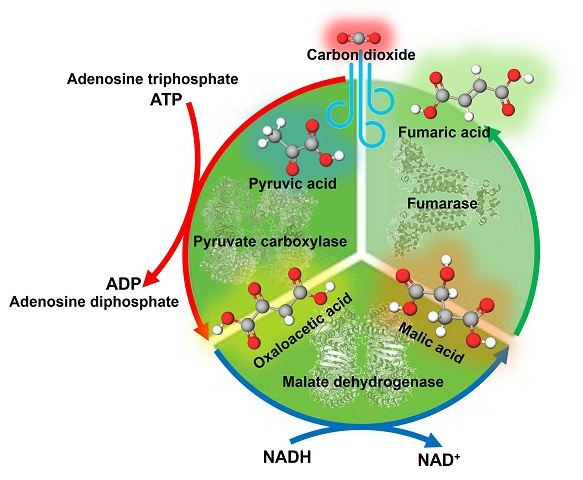Research News
Oct 4, 2024
- Research Centers
- Science
Improving fumaric acid production efficiency through a ‘more haste, less speed’ strategy
Future of bioplastics made from carbon dioxide and biomass molecules could rely on more enzymes, shorter incubation periods
Fumaric acid synthesis using multi-enzyme system
Biodegradable plastic production requires better raw material outputs to meet the growing demand for greener solutions.
Credit: Osaka Metropolitan University

As plastic waste continues to build up faster than it can decompose, the need for biodegradable solutions is evident.
Previously, Professor Yutaka Amao and his team at Osaka Metropolitan University’s Research Center for Artificial Photosynthesis succeeded in synthesizing fumaric acid, a raw material for biodegradable plastics from biomass-derived pyruvic acid and carbon dioxide. However, the fumaric acid production process reported earlier has a problem with producing undesirable substances as byproducts in addition to L-malic acid, which is required as an intermediate.
Continuing this research, the team devised a “more haste, less speed” strategy that supplements the two reactions performed by a single malate dehydrogenase decarboxylase with two different enzymes. Based on this strategy, it is predicted that an efficient fumaric acid production system could be developed from bio-based pyruvate material and carbon dioxide.
As a result, the team succeeded in converting approximately 80% of the pyruvic acid into L-malic acid in 5 hours of incubation, compared to the previous result of approximately 46% conversion in 7 hours. Furthermore, by adding fumarase to this reaction system, the efficiency of converting the pyruvic acid to fumaric acid was improved from the conventional 10% to about 16% in 5 hours of incubation.
“In the conventional fumaric acid production system, only pure carbon dioxide gas could be used, but this research has revealed the possibility of using low-concentration carbon dioxide gas emitted from thermal power plants and steel mills,” stated Professor Amao. “In addition, we have also started to develop a system for producing fumaric acid using light energy as an application of artificial photosynthesis technology.”
The findings were published in RSC Sustainability.
Funding
This work was partially supported by the Grant-in-Aid for Specially Promoted Research (23H05404), Scientific Research (B) (22H01872) and (22H01871), and by the Institute for Fermentation, Osaka (IFO) (G-2023-3-050).
Paper information
Journal: RSC Sustainability
Title: A multi-biocatalytic system for effective fumarate synthesis from pyruvate and gaseous CO2
DOI: 10.1039/D3SU00486D
Authors: Mika Takeuchi, Yutaka Amao
Published: 22 July 2024
URL: https://doi.org/10.1039/D3SU00486D
Contact
Research Center for Artificial Photosynthesis
Email: amao[at]omu.ac.jp
*Please change [at] to @.
SDGs
